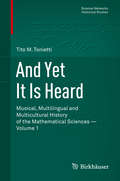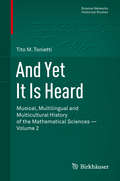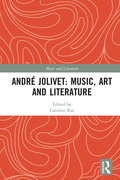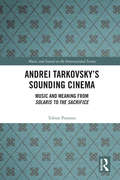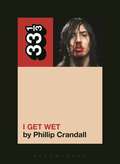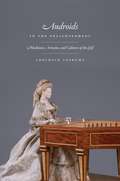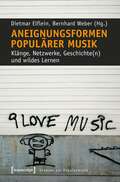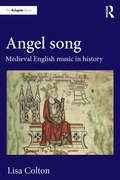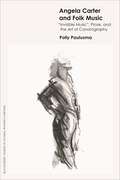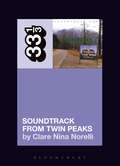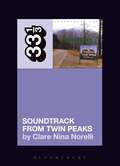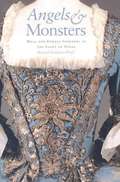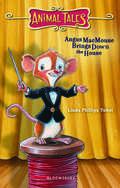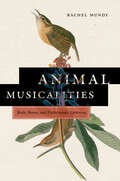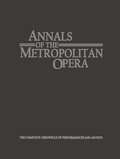- Table View
- List View
And Yet It Is Heard: Musical, Multilingual and Multicultural History of the Mathematical Sciences - Volume 1 (Science Networks. Historical Studies #46)
by Tito M. ToniettiWe bring into full light some excerpts on musical subjects which were until now scattered throughout the most famous scientific texts. The main scientific and musical cultures outside of Europe are also taken into consideration. The first and most important property to underline in the scientific texts examined here is the language they are written in. This means that our multicultural history of the sciences necessarily also becomes a review of the various dominant languages used in the different historical contexts. In this volume, the history of the development of the sciences is told as it happened in real contexts, not in an alienated ideal world.
And Yet It Is Heard: Musical, Multilingual and Multicultural History of the Mathematical Sciences - Volume 2 (Science Networks. Historical Studies #47)
by Tito M. ToniettiWe bring into full light some excerpts on musical subjects which were until now scattered throughout the most famous scientific texts. The main scientific and musical cultures outside of Europe are also taken into consideration. The first and most important property to underline in the scientific texts examined here is the language they are written in. This means that our multicultural history of the sciences necessarily also becomes a review of the various dominant languages used in the different historical contexts. In this volume, the history of the development of the sciences is told as it happened in real contexts, not in an alienated ideal world.
André Jolivet: Music, Art and Literature (Music and Literature)
by Caroline RaeThis first book in English on the French composer André Jolivet (1905–1974) investigates his music, life and influence. A pupil of Varèse and colleague of Messiaen in La Jeune France, Jolivet is a major figure in French music of the twentieth century. His music combines innovative language with spirituality, summarised in his self-declared axiom to ‘restore music’s ancient original meaning when it was the magic and incantatory expression of the sacred in human communities’. The book’s contextual introduction is followed by contributions, edited by Caroline Rae, from leading international scholars including the composer’s daughter Christine Jolivet-Erlih. These assess Jolivet’s output and activities from the 1920s through to his last works, exploring creative process, aesthetic, his relationship with the exotic and influences from literature. They also examine, for the first time, the significance of Jolivet’s involvement with the visual arts and his activities as conductor, teacher and critic. A chronology of Jolivet’s life and works with details of first performances provides valuable overview and reference. This fascinating and comprehensive volume is an indispensable source for research into French music and culture of the twentieth century.
André Jolivet: Music, Art and Literature (Music and Literature)
by Caroline RaeThis first book in English on the French composer André Jolivet (1905–1974) investigates his music, life and influence. A pupil of Varèse and colleague of Messiaen in La Jeune France, Jolivet is a major figure in French music of the twentieth century. His music combines innovative language with spirituality, summarised in his self-declared axiom to ‘restore music’s ancient original meaning when it was the magic and incantatory expression of the sacred in human communities’. The book’s contextual introduction is followed by contributions, edited by Caroline Rae, from leading international scholars including the composer’s daughter Christine Jolivet-Erlih. These assess Jolivet’s output and activities from the 1920s through to his last works, exploring creative process, aesthetic, his relationship with the exotic and influences from literature. They also examine, for the first time, the significance of Jolivet’s involvement with the visual arts and his activities as conductor, teacher and critic. A chronology of Jolivet’s life and works with details of first performances provides valuable overview and reference. This fascinating and comprehensive volume is an indispensable source for research into French music and culture of the twentieth century.
Andrei Tarkovsky's Sounding Cinema: Music and Meaning from Solaris to The Sacrifice (Music and Sound on the International Screen)
by Tobias PontaraAndrei Tarkovsky's Sounding Cinema adds a new dimension to our understanding and appreciation of the work of Russian director Andrei Tarkovsky (1932–1986) through an exploration of the presence of music and sound in his films. The first comprehensive study in English concentrating on the soundtrack in Tarkovsky’s cinema, this book reveals how Tarkovsky’s use of electronic music, electronically manipulated sound, traditional folk songs and fragments of canonized works of Western art music plays into the philosophical, existential and ethical themes recurring throughout his work. Exploring the multilayered relationship between music, sound, film image and narrative space, Pontara provides penetrating and innovative close readings of Solaris (1972), Mirror (1975), Stalker (1979), Nostalghia (1983) and The Sacrifice (1986) and in turn deeply enriches critical understanding of Tarkovsky’s films and their relation to the broader traditions of European art cinema. An excellent resource for scholars, researchers and students interested in European art cinema and the role of music in film, as well as for film aficionados interested in Tarkovsky’s work.
Andrei Tarkovsky's Sounding Cinema: Music and Meaning from Solaris to The Sacrifice (Music and Sound on the International Screen)
by Tobias PontaraAndrei Tarkovsky's Sounding Cinema adds a new dimension to our understanding and appreciation of the work of Russian director Andrei Tarkovsky (1932–1986) through an exploration of the presence of music and sound in his films. The first comprehensive study in English concentrating on the soundtrack in Tarkovsky’s cinema, this book reveals how Tarkovsky’s use of electronic music, electronically manipulated sound, traditional folk songs and fragments of canonized works of Western art music plays into the philosophical, existential and ethical themes recurring throughout his work. Exploring the multilayered relationship between music, sound, film image and narrative space, Pontara provides penetrating and innovative close readings of Solaris (1972), Mirror (1975), Stalker (1979), Nostalghia (1983) and The Sacrifice (1986) and in turn deeply enriches critical understanding of Tarkovsky’s films and their relation to the broader traditions of European art cinema. An excellent resource for scholars, researchers and students interested in European art cinema and the role of music in film, as well as for film aficionados interested in Tarkovsky’s work.
Andrew W.K.'s I Get Wet (33 1/3)
by Phillip Crandall"It's Time To Party," the first track off of I Get Wet, opens with a rapid-fire guitar line - nothing fancy, just a couple crunchy power chords to acclimate the ears - repeated twice before a booming bass drum joins in to provide a quarter-note countdown. A faint, swirling effect intensifies with each bass kick and, by the eighth one, the ears have prepped themselves for the metal mayhem they are about to receive. When it all drops, and the joyous onslaught of a hundred guitars is finally realized, you'll have to forgive your ears for being duped into a false sense of security, because it's that second intensified drop a few seconds later - the one where yet more guitars manifest and Andrew W.K. slam-plants his vocal flag by screaming the song's titular line - that really floods the brain with endorphins, serotonin, dopamine, and whatever else formulates invincibility.Polished to a bright overdubbed-to-oblivion sheen, the party-preaching I Get Wet didn't capture the zeitgeist of rock at the turn of the century; it captured the timelessness of youth, as energized, awesome, and unapologetically stupid as ever. With insights from friends and unprecedented help from the mythological maniac himself - whose sermon and pop sensibilities continue to polarize - this book chronicles the sound's evolution, uncovers the relevance of Steev Mike, and examines how Andrew W.K.'s inviting, inclusive lyrics create the ultimate shared experience between artist and audience.
Andrew W.K.'s I Get Wet (33 1/3)
by Phillip Crandall"It's Time To Party," the first track off of I Get Wet, opens with a rapid-fire guitar line - nothing fancy, just a couple crunchy power chords to acclimate the ears - repeated twice before a booming bass drum joins in to provide a quarter-note countdown. A faint, swirling effect intensifies with each bass kick and, by the eighth one, the ears have prepped themselves for the metal mayhem they are about to receive. When it all drops, and the joyous onslaught of a hundred guitars is finally realized, you'll have to forgive your ears for being duped into a false sense of security, because it's that second intensified drop a few seconds later - the one where yet more guitars manifest and Andrew W.K. slam-plants his vocal flag by screaming the song's titular line - that really floods the brain with endorphins, serotonin, dopamine, and whatever else formulates invincibility.Polished to a bright overdubbed-to-oblivion sheen, the party-preaching I Get Wet didn't capture the zeitgeist of rock at the turn of the century; it captured the timelessness of youth, as energized, awesome, and unapologetically stupid as ever. With insights from friends and unprecedented help from the mythological maniac himself - whose sermon and pop sensibilities continue to polarize - this book chronicles the sound's evolution, uncovers the relevance of Steev Mike, and examines how Andrew W.K.'s inviting, inclusive lyrics create the ultimate shared experience between artist and audience.
Androids in the Enlightenment: Mechanics, Artisans, and Cultures of the Self
by Adelheid VoskuhlThe eighteenth century saw the creation of a number of remarkable mechanical androids: at least ten prominent automata were built between 1735 and 1810 by clockmakers, court mechanics, and other artisans from France, Switzerland, Austria, and the German lands. Designed to perform sophisticated activities such as writing, drawing, or music making, these “Enlightenment automata” have attracted continuous critical attention from the time they were made to the present, often as harbingers of the modern industrial age, an era during which human bodies and souls supposedly became mechanized. In Androids in the Enlightenment, Adelheid Voskuhl investigates two such automata—both depicting piano-playing women. These automata not only play music, but also move their heads, eyes, and torsos to mimic a sentimental body technique of the eighteenth century: musicians were expected to generate sentiments in themselves while playing, then communicate them to the audience through bodily motions. Voskuhl argues, contrary to much of the subsequent scholarly conversation, that these automata were unique masterpieces that illustrated the sentimental culture of a civil society rather than expressions of anxiety about the mechanization of humans by industrial technology. She demonstrates that only in a later age of industrial factory production did mechanical androids instill the fear that modern selves and societies had become indistinguishable from machines.
Androids in the Enlightenment: Mechanics, Artisans, and Cultures of the Self
by Adelheid VoskuhlThe eighteenth century saw the creation of a number of remarkable mechanical androids: at least ten prominent automata were built between 1735 and 1810 by clockmakers, court mechanics, and other artisans from France, Switzerland, Austria, and the German lands. Designed to perform sophisticated activities such as writing, drawing, or music making, these “Enlightenment automata” have attracted continuous critical attention from the time they were made to the present, often as harbingers of the modern industrial age, an era during which human bodies and souls supposedly became mechanized. In Androids in the Enlightenment, Adelheid Voskuhl investigates two such automata—both depicting piano-playing women. These automata not only play music, but also move their heads, eyes, and torsos to mimic a sentimental body technique of the eighteenth century: musicians were expected to generate sentiments in themselves while playing, then communicate them to the audience through bodily motions. Voskuhl argues, contrary to much of the subsequent scholarly conversation, that these automata were unique masterpieces that illustrated the sentimental culture of a civil society rather than expressions of anxiety about the mechanization of humans by industrial technology. She demonstrates that only in a later age of industrial factory production did mechanical androids instill the fear that modern selves and societies had become indistinguishable from machines.
Androids in the Enlightenment: Mechanics, Artisans, and Cultures of the Self
by Adelheid VoskuhlThe eighteenth century saw the creation of a number of remarkable mechanical androids: at least ten prominent automata were built between 1735 and 1810 by clockmakers, court mechanics, and other artisans from France, Switzerland, Austria, and the German lands. Designed to perform sophisticated activities such as writing, drawing, or music making, these “Enlightenment automata” have attracted continuous critical attention from the time they were made to the present, often as harbingers of the modern industrial age, an era during which human bodies and souls supposedly became mechanized. In Androids in the Enlightenment, Adelheid Voskuhl investigates two such automata—both depicting piano-playing women. These automata not only play music, but also move their heads, eyes, and torsos to mimic a sentimental body technique of the eighteenth century: musicians were expected to generate sentiments in themselves while playing, then communicate them to the audience through bodily motions. Voskuhl argues, contrary to much of the subsequent scholarly conversation, that these automata were unique masterpieces that illustrated the sentimental culture of a civil society rather than expressions of anxiety about the mechanization of humans by industrial technology. She demonstrates that only in a later age of industrial factory production did mechanical androids instill the fear that modern selves and societies had become indistinguishable from machines.
Androids in the Enlightenment: Mechanics, Artisans, and Cultures of the Self
by Adelheid VoskuhlThe eighteenth century saw the creation of a number of remarkable mechanical androids: at least ten prominent automata were built between 1735 and 1810 by clockmakers, court mechanics, and other artisans from France, Switzerland, Austria, and the German lands. Designed to perform sophisticated activities such as writing, drawing, or music making, these “Enlightenment automata” have attracted continuous critical attention from the time they were made to the present, often as harbingers of the modern industrial age, an era during which human bodies and souls supposedly became mechanized. In Androids in the Enlightenment, Adelheid Voskuhl investigates two such automata—both depicting piano-playing women. These automata not only play music, but also move their heads, eyes, and torsos to mimic a sentimental body technique of the eighteenth century: musicians were expected to generate sentiments in themselves while playing, then communicate them to the audience through bodily motions. Voskuhl argues, contrary to much of the subsequent scholarly conversation, that these automata were unique masterpieces that illustrated the sentimental culture of a civil society rather than expressions of anxiety about the mechanization of humans by industrial technology. She demonstrates that only in a later age of industrial factory production did mechanical androids instill the fear that modern selves and societies had become indistinguishable from machines.
Androids in the Enlightenment: Mechanics, Artisans, and Cultures of the Self
by Adelheid VoskuhlThe eighteenth century saw the creation of a number of remarkable mechanical androids: at least ten prominent automata were built between 1735 and 1810 by clockmakers, court mechanics, and other artisans from France, Switzerland, Austria, and the German lands. Designed to perform sophisticated activities such as writing, drawing, or music making, these “Enlightenment automata” have attracted continuous critical attention from the time they were made to the present, often as harbingers of the modern industrial age, an era during which human bodies and souls supposedly became mechanized. In Androids in the Enlightenment, Adelheid Voskuhl investigates two such automata—both depicting piano-playing women. These automata not only play music, but also move their heads, eyes, and torsos to mimic a sentimental body technique of the eighteenth century: musicians were expected to generate sentiments in themselves while playing, then communicate them to the audience through bodily motions. Voskuhl argues, contrary to much of the subsequent scholarly conversation, that these automata were unique masterpieces that illustrated the sentimental culture of a civil society rather than expressions of anxiety about the mechanization of humans by industrial technology. She demonstrates that only in a later age of industrial factory production did mechanical androids instill the fear that modern selves and societies had become indistinguishable from machines.
Androids in the Enlightenment: Mechanics, Artisans, and Cultures of the Self
by Adelheid VoskuhlThe eighteenth century saw the creation of a number of remarkable mechanical androids: at least ten prominent automata were built between 1735 and 1810 by clockmakers, court mechanics, and other artisans from France, Switzerland, Austria, and the German lands. Designed to perform sophisticated activities such as writing, drawing, or music making, these “Enlightenment automata” have attracted continuous critical attention from the time they were made to the present, often as harbingers of the modern industrial age, an era during which human bodies and souls supposedly became mechanized. In Androids in the Enlightenment, Adelheid Voskuhl investigates two such automata—both depicting piano-playing women. These automata not only play music, but also move their heads, eyes, and torsos to mimic a sentimental body technique of the eighteenth century: musicians were expected to generate sentiments in themselves while playing, then communicate them to the audience through bodily motions. Voskuhl argues, contrary to much of the subsequent scholarly conversation, that these automata were unique masterpieces that illustrated the sentimental culture of a civil society rather than expressions of anxiety about the mechanization of humans by industrial technology. She demonstrates that only in a later age of industrial factory production did mechanical androids instill the fear that modern selves and societies had become indistinguishable from machines.
Aneignungsformen populärer Musik: Klänge, Netzwerke, Geschichte(n) und wildes Lernen (Studien zur Popularmusik)
by Dietmar Elflein Bernhard WeberOb Soul in Deutschland, progressive Landdiskotheken in der Provinz oder neue Mixingkonzepte im Loudness War - das Spektrum der Aneignungsformen populärer Musik ist vielfältig. Für die musikwissenschaftliche, kulturwissenschaftliche und musikpädagogische Forschung ist das Thema, das sich weitgehend außerhalb formaler Bildungskontexte abspielt, ein bislang unerschlossenes Gebiet. Der Band ändert dies. Er versammelt theoretische Perspektiven sowie historische und aktuelle Fallbeispiele und spiegelt den aktuellen internationalen Diskussionsstand wider. Daraus ergeben sich maßgebende Impulse für weiterführende Forschungsaktivitäten auch in verwandten Fachdisziplinen.
Angel Song: Medieval English Music In History
by Lisa ColtonAlthough medieval English music has been relatively neglected in comparison with repertoire from France and Italy, there are few classical musicians today who have not listened to the thirteenth-century song ‘Sumer is icumen in’, or read of the achievements and fame of fifteenth-century composer John Dunstaple. Similarly, the identification of a distinctively English musical style (sometimes understood as the contenance angloise) has been made on numerous occasions by writers exploring the extent to which English ideas influenced polyphonic composition abroad. Angel song: Medieval English music in history examines the ways in which the standard narratives of English musical history have been crafted, from the Middle Ages to the present. Colton challenges the way in which the concept of a canon of English music has been built around a handful of pieces, composers and practices, each of which offers opportunities for a reappraisal of English musical and devotional cultures between 1250 and 1460.
Angel Song: Medieval English Music in History
by Lisa ColtonAlthough medieval English music has been relatively neglected in comparison with repertoire from France and Italy, there are few classical musicians today who have not listened to the thirteenth-century song ‘Sumer is icumen in’, or read of the achievements and fame of fifteenth-century composer John Dunstaple. Similarly, the identification of a distinctively English musical style (sometimes understood as the contenance angloise) has been made on numerous occasions by writers exploring the extent to which English ideas influenced polyphonic composition abroad. Angel song: Medieval English music in history examines the ways in which the standard narratives of English musical history have been crafted, from the Middle Ages to the present. Colton challenges the way in which the concept of a canon of English music has been built around a handful of pieces, composers and practices, each of which offers opportunities for a reappraisal of English musical and devotional cultures between 1250 and 1460.
Angela Carter and Folk Music: 'Invisible Music', Prose and the Art of Canorography (Bloomsbury Studies in Global Women’s Writing)
by Polly PaulusmaFrom her unique standpoint as singer-songwriter-scholar, Polly Paulusma examines the influences of Carter's 1960s folk singing, unknown until now, on her prose writing. Recent critical attention has focused on Carter's relationship with folk/fairy tales, but this book uses a newly available archive containing Carter's folk song notes, books, LPs and recordings to change the debate, proving Carter performed folk songs. Placing this archive alongside the album sleeve notes Carter wrote and her diaries and essays, it reimagines Carter's prose as a vehicle for the singing voice, and reveals a writing style imbued with 'songfulness' informed by her singing praxis.Reading Carter's texts through songs she knew and sang, this book shows, from influences of rhythm, melodic shape, thematic focus, imagery, 'voice' and 'breath', how Carter steeped her writing with folk song's features to produce 'canorography': song-infused prose. Concluding with a discussion of Carter's profound influence on songwriters, focusing on the author's interview with Emily Portman, this book invites us to reimagine Carter's prose as audial event, dissolving boundaries between prose and song, between text and reader, between word and sound, in an ever-renewing act of sympathetic resonance.
Angela Carter and Folk Music: 'Invisible Music', Prose and the Art of Canorography (Bloomsbury Studies in Global Women’s Writing)
by Polly PaulusmaFrom her unique standpoint as singer-songwriter-scholar, Polly Paulusma examines the influences of Carter's 1960s folk singing, unknown until now, on her prose writing. Recent critical attention has focused on Carter's relationship with folk/fairy tales, but this book uses a newly available archive containing Carter's folk song notes, books, LPs and recordings to change the debate, proving Carter performed folk songs. Placing this archive alongside the album sleeve notes Carter wrote and her diaries and essays, it reimagines Carter's prose as a vehicle for the singing voice, and reveals a writing style imbued with 'songfulness' informed by her singing praxis.Reading Carter's texts through songs she knew and sang, this book shows, from influences of rhythm, melodic shape, thematic focus, imagery, 'voice' and 'breath', how Carter steeped her writing with folk song's features to produce 'canorography': song-infused prose. Concluding with a discussion of Carter's profound influence on songwriters, focusing on the author's interview with Emily Portman, this book invites us to reimagine Carter's prose as audial event, dissolving boundaries between prose and song, between text and reader, between word and sound, in an ever-renewing act of sympathetic resonance.
Angelo Badalamenti's Soundtrack from Twin Peaks (33 1/3)
by Clare Nina NorelliWhen Twin Peaks debuted on the ABC network on the night of April 8, 1990, thirty-five million viewers tuned in to some of the most unusual television of their lives. Centered on an eccentric, coffee-loving FBI agent's investigation into the murder of a small town teen queen, Twin Peaks brought the aesthetic of arthouse cinema to a prime time television audience and became a cult sensation in the process.Part of Twin Peaks' charm was its unforgettable soundtrack by Angelo Badalamenti, a longtime musical collaborator of film director and Twin Peaks co-creator David Lynch. Badalamenti's evocative music, with its haunting themes and jazzy moodscapes, served as a constant in a narrative that was often unhinged and went on to become one of the most popular and influential television soundtracks of all time. How did a unique collaborative process between a director and composer result in a perfectly postmodern soundtrack that ran the gamut of musical styles from jazz to dreamy pop to synthesizer doom and beyond? And how did Badalamenti's musical cues work with Twin Peaks' visuals, constantly evolving and playing off viewers' expectations and associations? Under the guidance of Angelo Badalamenti's beautifully dark sonic palette, Clare Nina Norelli delves deep into the world of Twin Peaks to answer all this and more.
Angelo Badalamenti's Soundtrack from Twin Peaks (33 1/3)
by Clare Nina NorelliWhen Twin Peaks debuted on the ABC network on the night of April 8, 1990, thirty-five million viewers tuned in to some of the most unusual television of their lives. Centered on an eccentric, coffee-loving FBI agent's investigation into the murder of a small town teen queen, Twin Peaks brought the aesthetic of arthouse cinema to a prime time television audience and became a cult sensation in the process.Part of Twin Peaks' charm was its unforgettable soundtrack by Angelo Badalamenti, a longtime musical collaborator of film director and Twin Peaks co-creator David Lynch. Badalamenti's evocative music, with its haunting themes and jazzy moodscapes, served as a constant in a narrative that was often unhinged and went on to become one of the most popular and influential television soundtracks of all time. How did a unique collaborative process between a director and composer result in a perfectly postmodern soundtrack that ran the gamut of musical styles from jazz to dreamy pop to synthesizer doom and beyond? And how did Badalamenti's musical cues work with Twin Peaks' visuals, constantly evolving and playing off viewers' expectations and associations? Under the guidance of Angelo Badalamenti's beautifully dark sonic palette, Clare Nina Norelli delves deep into the world of Twin Peaks to answer all this and more.
Angels & Monsters: Male and Female Sopranos in the Story of Opera, 1600–1900 (PDF)
by Richard Somerset-WardDuring its first two centuries, opera was dominated by sopranos. There were male sopranos, or castrati, whose supercharged voices (female vocal cords powered by male lungs) were capable of feats of vocalism that are hard to imagine today. And there were female sopranos, or prima donnas, whose long battle for social acceptance and top billing was crowned in the early nineteenth century when the castrati disappeared from the opera stage and left them supreme. Whether they were male or female, these singers were amazing virtuosi, perhaps the greatest singers there have ever been - "angels." Unfortunately, some of them (and often the most famous) were also capable of behaving extremely badly, both on and off stage - "monsters." This book tells their colorful stories. Besides providing fascinating anecdotes about some of those who graced and disgraced the operatic stage, Richard Somerset-Ward tells the story of their greatest glory-the singing tradition they founded and perfected, which we know as bel canto and which is still the backbone of operatic singing today. Rich in musical, social, and cultural lore, Angels and Monsters illuminates a unique and vanished tradition.
Angus MacMouse Brings Down the House (Animal Tales)
by Linda Phillips TeitelWhen a poor street mouse named Angus accidentally wanders onto the stage of the opera, he scares the soprano so much that she sings a record-breaking high note. Word gets out, and soon the soprano, Minnie McGraw, becomes world famous, and goes on tour with Angus as her secret. But things go wrong when Angus becomes famous in his own right and Minnie grows jealous. Minnie and Carlo, the scheming tenor, come up with a plan to mousenap Angus! Trapped in a cage backstage, will Angus be able to escape in time to save the opera company from ruin?
Animal Musicalities: Birds, Beasts, and Evolutionary Listening (Music / Culture)
by Rachel MundyOver the past century and a half, the voices and bodies of animals have been used by scientists and music experts as a benchmark for measures of natural difference. Animal Musicalities traces music's taxonomies from Darwin to digital bird guides to show how animal song has become the starting point for enduring evaluations of species, races, and cultures. By examining the influential efforts made by a small group of men and women to define human diversity in relation to animal voices, this book raises profound questions about the creation of modern human identity, and the foundations of modern humanism.
